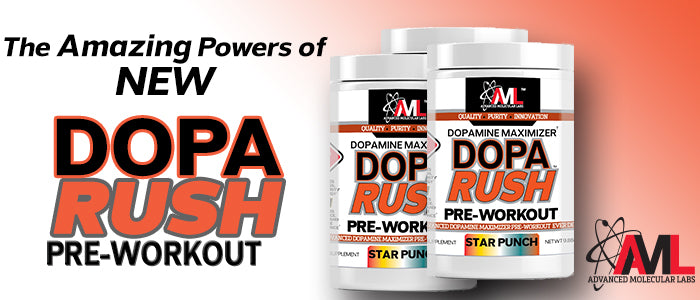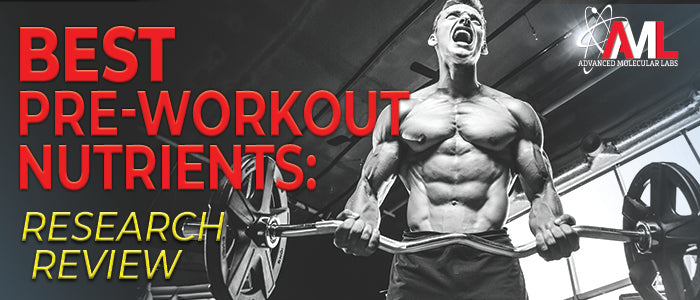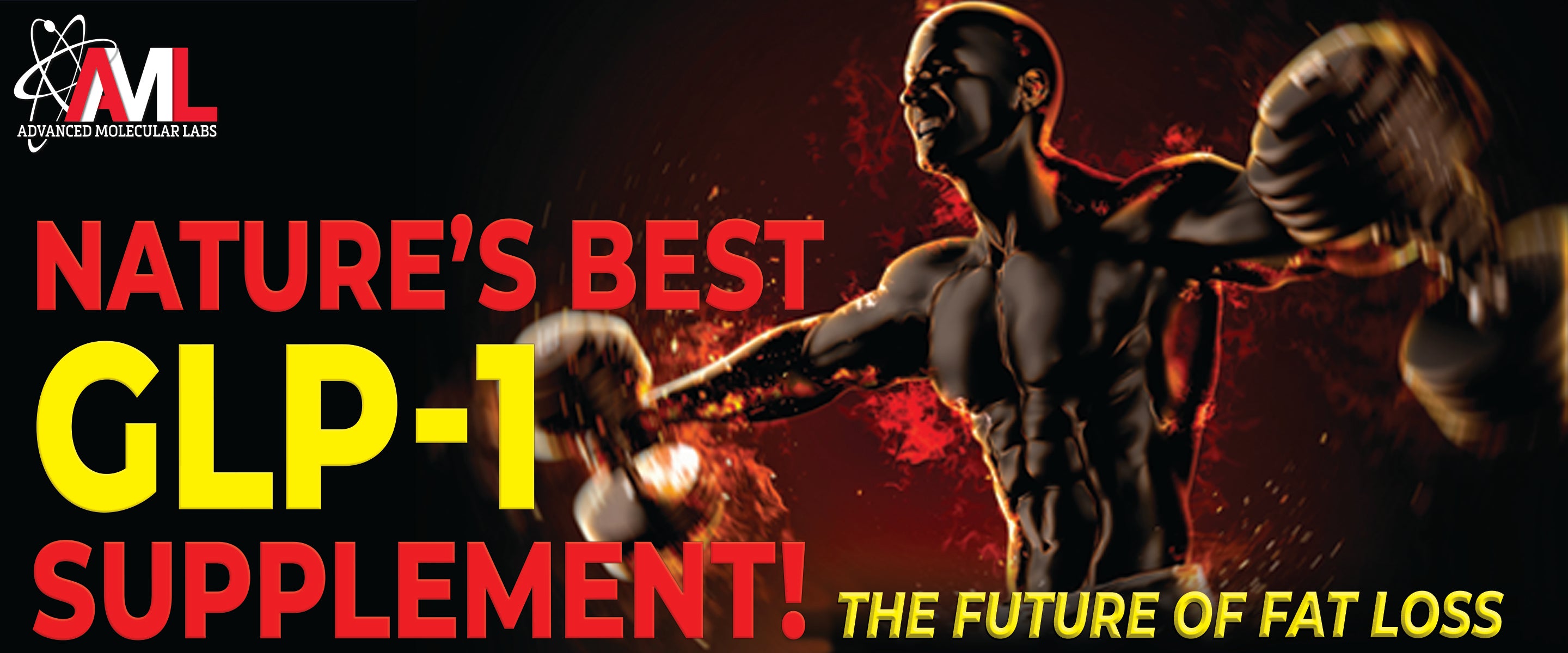


The Amazing Powers of NEW Dopa Rush Pre-Workout!
By Robert Schinetsky
Over the years, Advanced Molecular Labs has made it a priority to formulate research-backed, efficaciously dosed supplements to enhance athletic performance.
It began with our flagship AML PreWorkout supplement and has continued over the years with such notable releases as DopaRush and Dopa Rush Cocktail.
Now, Advanced Molecular Labs gets ready to take yet another step forward with the release of DopaRush Pre-workout.
DopaRush Pre-Workout retains all of the essential dopamine-boosting elements of the original DopaRush and DopaRush Cocktail and adds in several prominent nitric oxide boosters and ergogenic aids to help you take your exercise performance to the next level!
Here’s what’s included in DopaRush Pre-Workout!
Inside Dopa Rush Pre-Workout
L-Citrulline
The amino acid arginine serves as the “fuel” for nitric oxide production.
Based on this, supplemental forms of arginine (such as L-arginine, arginine HCl, and Arginine AKG) have commonly been included in dietary supplement to enhance nitric oxide production and support increased blood flow.
The problem with arginine is that it has terrible bioavailability (~20%), which means the body cannot efficiently use it.[1]
In order to derive any tangible nitric oxide benefits from L-arginine supplementation, a rather large dose needs to be ingested (10-20g). However, research notes consuming large doses of L-arginine can bring on a lot of unwanted GI distress.[1]
A superior option for those looking to support nitric oxide production is the arginine precursor, L-Citrulline.
L-Citrulline is a nonessential amino acid that offers a high degree of bioavailability[3], and it’s easy on the GI system.[2]
More importantly, research shows that L-Citrulline is more effective for increasing plasma arginine levels than even L-arginine supplementation!
In other words, if you want greater nitric oxide production, you want to use L-Citrulline, not arginine-based supplements.
Dopa Rush Pre-Workout includes the full research-backed dose of 6 grams pure L-Citrulline to support nitric oxide production, blood flow, and athletic performance.
L-Citrulline supplementation has been noted to reduce completion time and improve subjective feelings of muscle fatigue and concentration immediately following exercise.[4]
Electrolytes for Added NO Support, Too!
Electrolytes are electrically charged minerals that regulate the amount of water in your body and help maintain the body's acid/base (pH) level. For these reasons, electrolyte supplementation has become a cornerstone of hydration and helping athletes avoid cramping and fatigue during training.
But that’s not all.
Electrolytes, namely potassium and magnesium, also support cardiovascular health and athletic performance. More specifically, research shows that potassium can soften the endothelium and increase nitric oxide production![45]
Magnesium also causes vasodilation by increasing nitric oxide synthase activity.[46]
Together, these minerals complement the NO-enhancing effects of L-Citrulline leading to greater blood vessel dilation, blood flow, and exercise performance.
L-Tyrosine
L-Tyrosine is an amino acid that fuels the biosynthesis of several highly important neurotransmitters and catecholamines, including dopamine, epinephrine (adrenaline), and norepinephrine (noradrenaline).
Supplementing with tyrosine helps provide the body with sufficient “raw material” to construct these highly important neurotransmitters.
Dopamine, as you may know, is most well-known for its role in feeling reward. However, the versatile neurotransmitter also plays a vital role in mood, memory, motivation, and motor control.
Deficiencies in the neurotransmitter can impact motivation, performance, mood, and cognition.
Furthermore, stress (such as intense exercise) can deplete dopamine stores in the brain, leading to increased fatigue and reduced athletic performance.[6]
Dopa Rush Pre-Workout contains 2 grams of L-Tyrosine, which has been shown in research to enhance mental and physical performance as well as memory.[6,7]
Furthermore, tyrosine supplementation at 2 grams per day has also been shown to help reduce stress and improve cognitive flexibility.[6,7,8]
Caffeine
Caffeine is a many splendored thing.
It increases mental energy, mood, and alertness.[11]
It heightens focus, and it even boosts performance by supporting nitric oxide production, enhancing muscle strength & power, and delaying the onset of fatigue.[9,10]
But, more importantly, caffeine is a stimulant that has been extensively researched and not only proven to be effective, but safe (when used in moderation).[9]
The energy and focus-boosting properties of caffeine come from a combination of effects on adenosine and dopamine receptors in the body.
Adenosine is an inhibitory neurotransmitter that dulls the firing of neurons, promoting feelings of lethargy, fatigue, and tiredness.
Since caffeine has a structural resemblance to adenosine, it can bind to the adenosine receptors, thereby preventing the adenosine molecule from binding. This results in increased feelings of arousal and alertness.
Caffeine also potentiates the release of dopamine in the brain as well as upregulates dopamine receptor availability and affinity.[10,16] This is part of the reason why having a morning cup of coffee seems to perk people up, aside from the fact that coffee is delicious!
Caffeine supplementation has been shown to be effective across a wide-spectrum of dosages.
AML Dopa Rush Pre-Workout contains 200mg caffeine per serving. This dose has been studied multiple times and shown to boost attention, heighten mood, and reduce fatigue.[12,13,14,15]
TeaCrine™
To complement the immediate burst in energy and motivation supplied by caffeine, DopaRush Pre-Workout has added TeaCrine™.
TeaCrine is a chemical cousin of caffeine that provides smooth, sustained energy.
It is naturally occurring in a number of plants, namely kucha tea Coffea robusta, and works similar to caffeine, in that it affects both adenosine and dopamine receptors, but in a slightly different manner (which is why the two have a synergistic effect when taken together).[16]
Caffeine is an orthosteric modulator of adenosine receptors in the brain, while TeaCrine is an allosteric modulator.
Without getting too “into the weeds”, orthosteric modulation is a more direct approach to getting a result (sort of like kicking in the front door of the house to get in), while allosteric modulation is a more subtle, sneaky option (much to slipping into the house through an open window).
In terms of perceived effects, caffeine delivers a powerful and noticeable increase in energy and alertness, while TeaCrine provides a more moderate, sustained, and “slow burning” energy.
Combining these two ingredients delivers the best of both worlds with fast-acting and long-lasting energy that helps avoids the crash and jitters commonly experienced when taking high doses of caffeine in isolation.
Additionally, research has found that the combination of caffeine and TeaCrine led to greater improvements in energy, mood, and performance than supplementing with caffeine alone.[18]
To top it off, TeaCrine does not come with habituation (tolerance build up), which means you get the same increase in energy, mood, and focus over and over again without having to continually up the dose.
Velvet Bean
Earlier we discussed the importance of Tyrosine in the production of dopamine -- it’s the building block from which the neurotransmitter is synthesized.
Well, en route to becoming dopamine, tyrosine is converted into L-3,4-dihydroxyphenylalanine (L-DOPA) by the enzyme tyrosine hydroxylase.
In other words, L-Dopa is the direct precursor to dopamine.
L-Dopa is naturally occurring in the body, and it’s also readily found in the plant commonly referred to as Velvet Bean (Mucuna pruriens).
Velvet bean has long been used as an all-natural herbal medicine and aphrodisiac due to its anti-diabetic, aphrodisiac, anti-neoplastic, anti-epileptic, and anti-microbial activities. Moreover, the plant has also been shown to be neuroprotective and exert analgesic (pain-relieving) and anti-inflammatory properties[19]
Research has found that supplementing with L-Dopa helps boost declining dopamine levels, making it an intriguing all-natural alternative for the treatment of Parkinson’s disease.[20]
In case you weren’t aware, Parkinson's disease is rooted in declining dopamine production and the death of dopamine-generating neurons.
Garcitrin™
If you’re familiar with the original DopaRush Cocktail, then you likely remember being introduced to Garcitrin™, Advanced Molecular Labs very own trademarked extract of Garcinia Indica standardized for 5% Garcinol.
Garcinol is a polyisoprenylated benzophenone derivative found in the rind of Garcinia indica which has traditionally been used for its antioxidant, anti-inflammatory, and anti-cancer properties.[21,24]
While garcinol is most well-known for it ability to scavenge free radicals, it also functions as a monoamine oxidase-B (MAO-B) inhibitor.[22]
In fact, garcinol’s MAO-B inhibiting properties are so potent that it is being researched as a possible treatment for Parkinson’s Disease.[22]
Why is an MAO-B inhibitor noteworthy in a pre workout?
Well, MAO-B is an enzyme that metabolizes (breaks down) certain neurotransmitters in the body, including dopamine, norepinephrine, and serotonin.
Researchers have begun developing a class of prescription medications based on MAO-B inhibition to treat the symptoms of Parkinson’s disease.
However, there are several naturally occurring MAO-B inhibitors, such as garcinol.
Another common MAO-B inhibitor seen in dietary supplements is hordenine; however, the FDA has recently added hordening to its “Advisory List,” which means the FDA is taking steps to further evaluate the ingredient and whether or not it is safe and/or effective.
Garcitrin™ (garcinol) offers a superior option to hordenine for the inhibition of MAO-B, which promotes longer-lasting dopamine levels in the body for greater energy, mood, and focus.
Polyphenols from Beet Root, Grape Skin & Blueberry Extract
Polyphenols are a group of beneficial compounds naturally occurring in plants, including fruits, vegetables, coffee, tea, dark chocolate and wine.
Much of the buzz around polyphenol intake is due to the fact that they function as antioxidants, meaning they help neutralize free radicals and thus oxidative stress. Polyphenols can also exert anti-inflammatory effects as well.
Beyond their health-promoting properties, polyphenols have received increasing interest in recent years for their ability to improve athletic performance.
More specifically, recent studies find supplementing with a polyphenol-rich extract significantly increased average power developed (5%), total power output (5%), and maximal peak power output (3.7%), and .[29]
Perhaps more noteworthy is that researchers observed these performance improvements without finding any increases in heart rate or fatigue, which indicates that polyphenol supplementation may improve endothelial function.
The ways in which polyphenols are believed to enhance performance are multifactorial.
Research notes that polyphenol intake can[25,26]:
- stimulate stress-related cell signaling pathways
- modulate muscle function and mitochondrial biogenesis (which enhances energy production) by activating sirtuins
- Upregulating the activity of the c-receptor coactivator activated by the peroxisome proliferator.
- Increasing the production of endothelial nitric oxide, which leads to greater flow-mediated dilation, endothelial function, and blood flow
Polyphenols have also been noted to reduce the amount of reactive oxygen species (ROS). Excess ROS blunts nitric oxide production via superoxide anions, which reduce the bioavailability of NO and promote vasoconstriction.
AML Dopa Rush Pre-Workout contains polyphenols derived from beet root, blueberry, and grape skin.
Of particular interest is some research which finds that dietary blueberries improve endothelial dysfunction by acting on eNOS/NO/cGMP signaling.[27]
Furthermore, blueberry polyphenols may also reduce neutrophil nicotinamide adenine dinucleotide phosphate (NADPH) oxidase activity and superoxide production, thereby decreasing the conversion of bioavailable nitric oxide to peroxynitrite.[28]
The end result is greater nitric oxide bioavailability and flow-mediated dilation (FMD).
It also bears mentioning that the NO-boosting effects of polyphenols from foods like blueberries extend beyond the heart and skeletal muscle systems. They may also support help the brain work better too!
Studies show that blueberry supplementation can improve memory and cognitive function by decreasing oxidative stress and inflammation.[30]
Black Pepper Extract (95% Piperine)
Black pepper extract is an incredibly common ingredient in dietary supplement, frequently included for its ability to enhance nutrient bioavailability via piperine’s inhibition of the drug-metabolizing enzyme CYP3A4 as well as the drug transporter P-glycoprotein.[31]
By inhibiting this crucial enzyme, black pepper extract can help prolong the “lifespan” of various nutrients in the bloodstream, thereby increasing their efficacy and duration of effects.
But that’s not the only reason black pepper extract is included.
Piperine (the primary alkaloid found in black pepper) also helps increase dopamine via activation of the TRPV receptor in the brain.[32]
And to top it off, piperine acts as a mild MAO inhibitor[33], complementing the effects of Garcitrin and further promoting sustained dopamine levels in the body for stronger, longer-lasting energy, mood, and motivation!
Folic Acid
Folic acid is a key “supporting” player in Dopa Rush.
It is a highly bioavailable form of Vitamin B9 that is required for the production of cofactor BH4, thereby supporting the production of dopamine.
Research notes an association between low dopamine levels (which are linked to depression) and low intakes of folic acid.[34]
Supplementing with folic acid helps support dopamine production by providing the body with requisite substrate needed to create the enzyme which is considered the “rate-limiting” step in the synthesis of dopamine.[35]
AML Dopa Rush Pre-Workout contains the research-recommended dose of 800mcg Folic Acid in every serving.[34]
Vitamin B-12
Vitamin B12 is B vitamin that plays an essential role in energy production. It also serves as an important cofactor in the synthesis of dopamine, too.
But, that’s not all...
Research indicates that treatment with B12 may prevent neurotoxicity.[36]
AML Dopa Rush Cocktail supplies the research-recommended dose of 1000mcg (1mg) of vitamin B-12 per serving.[34]
NO BCAAs or Taurine!
In an effort to up the serving size of pre-workout supplements, companies will often include a quartet of two very cheap amino acids -- the three BCAAs (leucine, valine, and isoleucine) and taurine.
AML Dopa Rush Pre-Workout does not.
Now, you might ask “why?”
First, there isn’t any real benefit to supplementing with BCAA in terms of boosting athletic performance or muscle growth if you are consuming sufficient amounts of dietary protein during the day.
Moreover, research indicates that BCAA supplementation, particularly leucine, can decrease dopamine levels.[38,39] This is due to the fact that leucine competitively inhibits L-Tyrosine, the amino acid used to synthesize dopamine.
Regarding taurine, it is a non-essential amino acid commonly used in energy drinks that regulates cell volume, helps muscles contract, and supports antioxidant defense systems.
While this might sound like a good ingredient to include in a pre-workout supplement, a few human studies have found that the combination of caffeine + taurine did not improve performance, energy, or attention.[40,41,42,43]
Interestingly, the combination of caffeine + taurine did negatively impact feelings of vigor and the tame the stimulating effects of caffeine.
Furthermore, the duo of caffeine and taurine was actually found to increase feelings of fatigue.
For these reasons, Advanced Molecular Labs does not include BCAA or taurine in Dopa Rush Pre-Workout.
However, leucine can be found in AML PostWorkout.
As many of you reading this may know, leucine is the anabolic “trigger” that activates mTOR and drives protein synthesis.
Research indicates that consuming leucine-alone (as opposed to being taken in combination with BCAA mixtures) results in greater elevation of blood leucine levels, which promotes greater activation of mTOR (and by extension, protein synthesis).
The reason you do not want to take leucine in combination with isoleucine and valine (as is commonly found in BCAA supplement) is that leucine shares the same amino acid transporters in the blood and muscle.[44]
The other reason that leucine is included in AML PostWorkout and not out pre workout supplements is that consuming leucine and BCAAs prior to training may reduce dopamine levels due to the fact that leucine may competitively inhibit tyrosine uptake into the brain.
As we mentioned above, Increased dopamine boosts mental energy and focus, enables the body to perform at a higher level, and helps reduce fatigue.
For these reasons, AML recommends pure leucine supplementation following training (not before) and that’s why you can find it included in our PostWorkout supplement.
The Bottom Line on Dopa Rush Pre-Workout
Dopamine is a neurotransmitter that plays a vital role in mood, motivation, focus, motor control, and decision-making.
DopaRush Pre-Workout contains the essential nutrients needed to support dopamine production and athletic performance during intense physical activity.
It is ideal to use as a pre workout, and it can also be used as a replacement for coffee or over-priced energy drinks.
Try DopaRush Pre-Workout today and witness the power of true research and development!
References
- George K. Grimble; Adverse Gastrointestinal Effects of Arginine and Related Amino Acids, The Journal of Nutrition, Volume 137, Issue 6, 1 June 2007, Pages 1693S–1701S, https://doi.org/10.1093/jn/137.6.1693S
- Bahri, S., Zerrouk, N., Aussel, C., Moinard, C., Crenn, P., Curis, E., … Sfar, S. (2013). Citrulline: from metabolism to therapeutic use. Nutrition (Burbank, Los Angeles County, Calif.), 29(3), 479–484. https://doi.org/10.1016/j.nut.2012.07.002
- Curis E., et. al; “Citrulline and the gut;”; Current Opinion in Clinical Nutrition and Metabolic Care; September 2007
- Suzuki, T., Morita, M., Kobayashi, Y. et al. Oral L-citrulline supplementation enhances cycling time trial performance in healthy trained men: Double-blind randomized placebo-controlled 2-way crossover study. J Int Soc Sports Nutr 13, 6 (2016) doi:10.1186/s12970-016-0117-z
- Meeusen R., De Meirleir K. (1995). Exercise and brain neurotransmission. Sports Med. 20, 160–188. 10.2165/00007256-199520030-00004
- Selasi Attipoe, Stacey A. Zeno, Courtney Lee, Cindy Crawford, Raheleh Khorsan, Avi R. Walter, Patricia A. Deuster, Tyrosine for Mitigating Stress and Enhancing Performance in Healthy Adult Humans, a Rapid Evidence Assessment of the Literature, Military Medicine, Volume 180, Issue 7, July 2015, Pages 754–765, https://doi.org/10.7205/MILMED-D-14-00594
- Steenbergen, L., Sellaro, R., Hommel, B., & Colzato, L. S. (2015). Tyrosine promotes cognitive flexibility: evidence from proactive vs. reactive control during task switching performance. Neuropsychologia, 69, 50–55. https://doi.org/10.1016/j.neuropsychologia.2015.01.022
- Jongkees, B. J., Hommel, B., Kuhn, S., & Colzato, L. S. (2015). Effect of tyrosine supplementation on clinical and healthy populations under stress or cognitive demands--A review. Journal of Psychiatric Research, 70, 50–57. https://doi.org/10.1016/j.jpsychires.2015.08.014
- Goldstein, E.R., Ziegenfuss, T., Kalman, D. et al. International society of sports nutrition position stand: caffeine and performance. J Int Soc Sports Nutr 7, 5 (2010) doi:10.1186/1550-2783-7-5
- Grgic, J., Trexler, E.T., Lazinica, B. et al. Effects of caffeine intake on muscle strength and power: a systematic review and meta-analysis. J Int Soc Sports Nutr 15, 11 (2018) doi:10.1186/s12970-018-0216-0
- Maridakis V. et al. (2009) Sensitivity to change in cognitive performance and mood measures of energy and fatigue in response to morning caffeine alone or in combination with carbohydrate.Int J Neurosci, 119:1239-58.
- Spriet LL. Exercise and sport performance with low doses of caffeine. Sports Med. 2014;44 Suppl 2(Suppl 2):S175–S184. doi:10.1007/s40279-014-0257-8
- Lieberman, H.R., R.J.Wurtman, G.G.Emde, and I.L.G.Coviella 1987. The effects of caffeine and aspirin on mood and performance. J. Clin. Pharmacol. 7:315–320
- Swift, C.G., and B.Tiplady 1988. The effects of age on the response to caffeine. Psychopharmacology 94:29–31
- Brunyé T.T. et al. (2010) Caffeine modulates attention network function.Brain Cogn, 72:181-8.
- Volkow ND, Wang G-J, Logan J, et al. Caffeine increases striatal dopamine D2/D3 receptor availability in the human brain. Translational Psychiatry. 2015;5(4):e549-. doi:10.1038/tp.2015.46.
- Taylor L, Mumford P, Roberts M, et al. Safety of TeaCrine®, a non-habituationg, naturally-occuring purine alkaloid over eight weeks of continuous use. J Int Soc Sports Nutr. 2-16;13(1):1-14. doi:10.1186/s12970-016-0113-3.
- Access O. Proceedings of the Fourteenth International Society of Sports Nutrition (ISSN) Conference and Expo. J Int Soc Sports Nutr. 2017;14(s2):31. doi:10.1186/s12970-017-0188-5
- Lampariello LR, Cortelazzo A, Guerranti R, Sticozzi C, Valacchi G. The Magic Velvet Bean of Mucuna pruriens. Journal of Traditional and Complementary Medicine. 2012;2(4):331-339.
- Hornykiewicz O. L-DOPA. Journal of Parkinson’s Disease. 2017;7(Suppl 1):S3-S10. doi:10.3233/JPD-179004.
- Fuchs RA, McLaughlin RJ. Garcinol: A Magic Bullet of Amnesia for Maladaptive Memories?. Neuropsychopharmacology. 2017;42(3):581–583. doi:10.1038/npp.2016.165 https://www.ncbi.nlm.nih.gov/pmc/articles/PMC5240180/
- Mazumder, M. K., Paul, R., Phukan, B. C., Dutta, A., Chakrabarty, J., Bhattacharya, P., & Borah, A. (2018). Garcinol, an effective monoamine oxidase-B inhibitor for the treatment of Parkinson’s disease. Medical Hypotheses, 117, 54–58. https://doi.org/10.1016/j.mehy.2018.06.009
- Lee, P.-S., Teng, C.-Y., Kalyanam, N., Ho, C.-T., & Pan, M.-H. (2019). Garcinol Reduces Obesity in High-Fat-Diet-Fed Mice by Modulating Gut Microbiota Composition. Molecular Nutrition & Food Research, 63(2), e1800390. https://doi.org/10.1002/mnfr.201800390
- Nadia Saadat and Smiti V. Gupta, “Potential Role of Garcinol as an Anticancer Agent,” Journal of Oncology, vol. 2012, Article ID 647206, 8 pages, 2012. https://doi.org/10.1155/2012/647206.
- Rodriguez-Mateos, A., Rendeiro, C., Bergillos-Meca, T., Tabatabaee, S., George, T. W., Heiss, C., & Spencer, J. P. (2013). Intake and time dependence of blueberry flavonoid–induced improvements in vascular function: a randomized, controlled, double-blind, crossover intervention study with mechanistic insights into biological activity. The American Journal of Clinical Nutrition, 98(5), 1179–1191.doi:10.3945/ajcn.113.066639
- D’Angelo, Stefania. "Polyphenols and Athletic Performance: A Review on Human Data." Plant Physiological Aspects of Phenolic Compounds, 2019.
- Cutler, B. R., Petersen, C., & Anandh Babu, P. V. (2016). Mechanistic insights into the vascular effects of blueberries: Evidence from recent studies. Molecular Nutrition & Food Research, 61(6), 1600271.doi:10.1002/mnfr.201600271
- Bowtell J, Kelly V. Fruit-Derived Polyphenol Supplementation for Athlete Recovery and Performance. Sports Med. 2019;49(Suppl 1):3–23. doi:10.1007/s40279-018-0998-x
- Cases J, Romain C, Marín-Pagán C, et al. Supplementation with a Polyphenol-Rich Extract, PerfLoad®, Improves Physical Performance during High-Intensity Exercise: A Randomized, Double Blind, Crossover Trial. Nutrients. 2017;9(4):421. doi:10.3390/nu9040421.
- Krikorian R, Shidler MD, Nash TA, et al. (2010). Blueberry Supplementation Improves Memory in Older Adults. J Agric Food Chem, 58(7): 3996–4000.
- Bhardwaj, R. K., Glaeser, H., Becquemont, L., Klotz, U., Gupta, S. K., & Fromm, M. F. (2002). Piperine, a major constituent of black pepper, inhibits human P-glycoprotein and CYP3A4. The Journal of Pharmacology and Experimental Therapeutics, 302(2), 645–650. https://doi.org/10.1124/jpet.102.034728
- McNamara FN, Randall A, Gunthorpe MJ. Effects of piperine, the pungent component of black pepper, at the human vanilloid receptor (TRPV1). Br J Pharmacol. 2005;144(6):781–790. doi:10.1038/sj.bjp.0706040
- Lee, S. A., Hong, S. S., Han, X. H., Hwang, J. S., Oh, G. J., Lee, K. S., Ro, J. S. (2005). Piperine from the fruits of Piper longum with inhibitory effect on monoamine oxidase and antidepressant-like activity. Chemical & Pharmaceutical Bulletin, 53(7), 832–835.
- Coppen, A., & Bolander-Gouaille, C. (2005). Treatment of depression: time to consider folic acid and vitamin B12. Journal of Psychopharmacology, 19(1), 59–65. https://doi.org/10.1177/0269881105048899
- Homma, D., Katoh, S., Tokuoka, H., & Ichinose, H. (2013). The role of tetrahydrobiopterin and catecholamines in the developmental regulation of tyrosine hydroxylase level in the brain. Journal of Neurochemistry, 126(1), 70–81. https://doi.org/10.1111/jnc.12287
- Adam Schaffner, Xianting Li, Yacob Gomez-Llorente, Emmanouela Leandrou, Anna Memou, Nicolina Clemente, Chen Yao, Farinaz Afsari, Lianteng Zhi, Nina Pan, Keita Morohashi, Xiaoluan Hua, Ming-Ming Zhou, Chunyu Wang, Hui Zhang, Shu G. Chen, Christopher J. Elliott, Hardy Rideout, Iban Ubarretxena-Belandia, Zhenyu Yue. Vitamin B12 modulates Parkinson’s disease LRRK2 kinase activity through allosteric regulation and confers neuroprotection. Cell Research, 2019; 29 (4): 313 DOI: 10.1038/s41422-019-0153-8
- Valizadeh M, Valizadeh N. Obsessive compulsive disorder as early manifestation of B12 deficiency. Indian J Psychol Med. 2011;33(2):203–204. doi:10.4103/0253-7176.92051
- Neuhaus AH, Goldberg TE, Hassoun Y, et al. Acute dopamine depletion with branched chain amino acids decreases auditory top-down event-related potentials in healthy subjects. Schizophrenia research. 2009;111(0):167-173. doi:10.1016/j.schres.2009.03.023.
- Choi S, Disilvio B, et al. Oral branched-chain amino acid supplements that reduce brain serotonin during exercise in rats also lower brain catecholamines. Amino Acids 2013.
- Jeffries, O., Hill, J., Patterson, S. D., & Waldron, M. (2017). Energy Drink Doses Of Caffeine And Taurine Have A Null Or Negative Effect On Sprint Performance. The Journal of Strength & Conditioning Research
- Bichler, A., Swenson, A., & Harris, M. A. (2006). A combination of caffeine and taurine has no effect on short term memory but induces changes in heart rate and mean arterial blood pressure. Amino Acids, 31(4), 471–476. https://doi.org/10.1007/s00726-005-0302-x
- Giles, G. E., Mahoney, C. R., Brunye, T. T., Gardony, A. L., Taylor, H. A., & Kanarek, R. B. (2012). Differential cognitive effects of energy drink ingredients: caffeine, taurine, and glucose. Pharmacology, Biochemistry, and Behavior, 102(4), 569–577. https://doi.org/10.1016/j.pbb.2012.07.004
- Peacock A, Martin FH, Carr A. Energy drink ingredients. Contribution of caffeine and taurine to performance outcomes. Appetite. 2013;64:1–4.
- Szmelcman S, Guggenheim K. Interference between leucine, isoleucine and valine during intestinal absorption. Biochem J. 1966;100(1):7–11. doi:10.1042/bj1000007
- Oberleithner H, Callies C, Kusche-Vihrog K, et al. Potassium softens vascular endothelium and increases nitric oxide release. Proc Natl Acad Sci U S A. 2009;106(8):2829–2834. doi:10.1073/pnas.0813069106
- Howard, A. B., Alexander, R. W., & Taylor, W. R. (1995). Effects of magnesium on nitric oxide synthase activity in endothelial cells. The American Journal of Physiology, 269(3 Pt 1), C612-8. https://doi.org/10.1152/ajpcell.1995.269.3.C612






